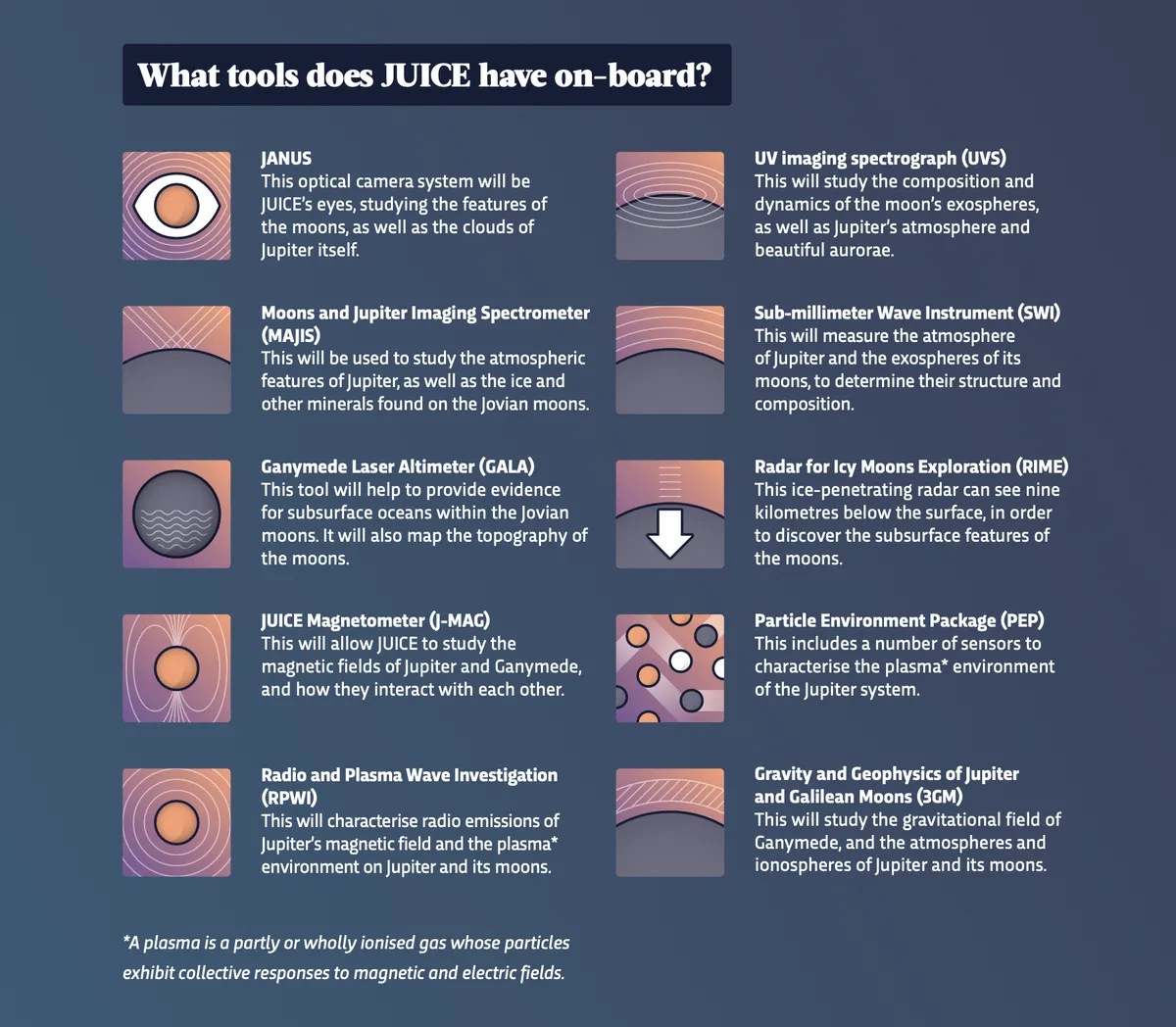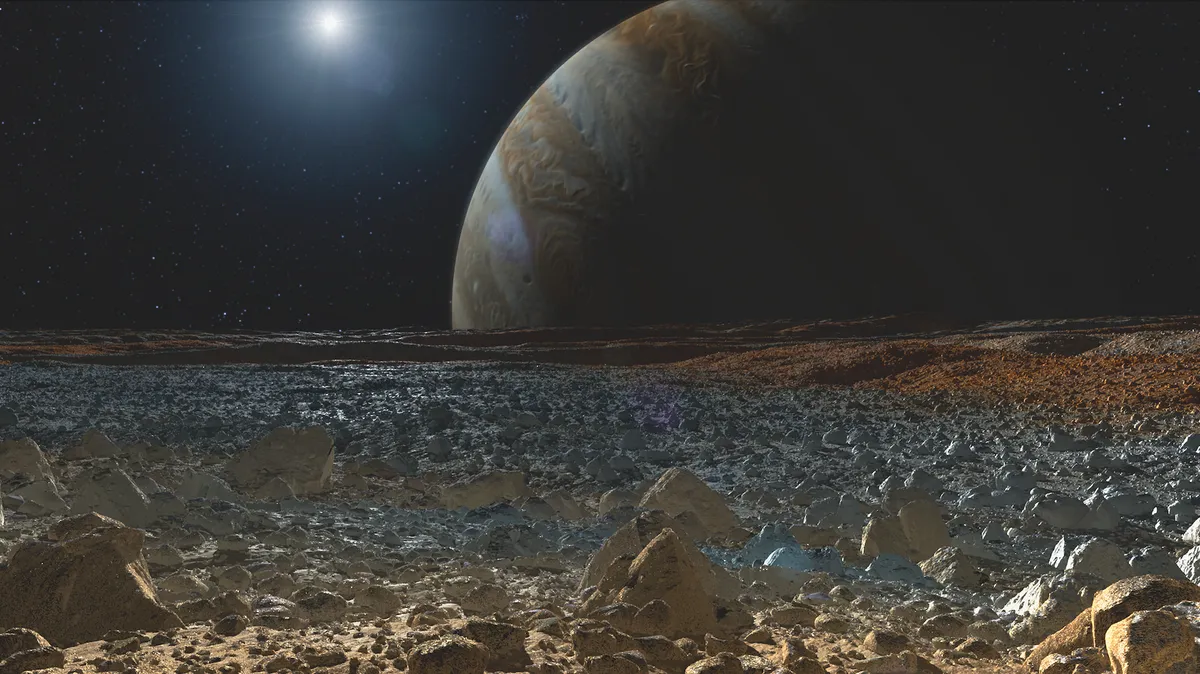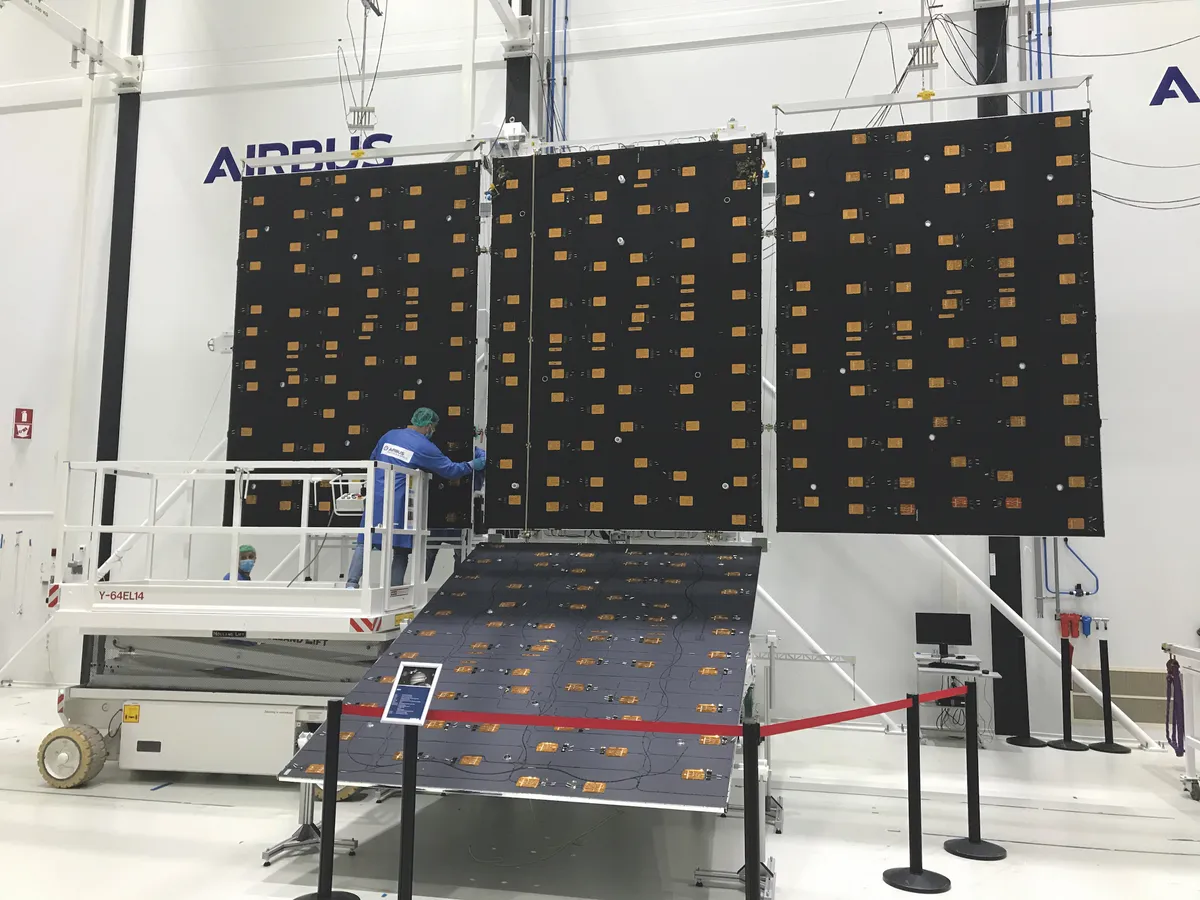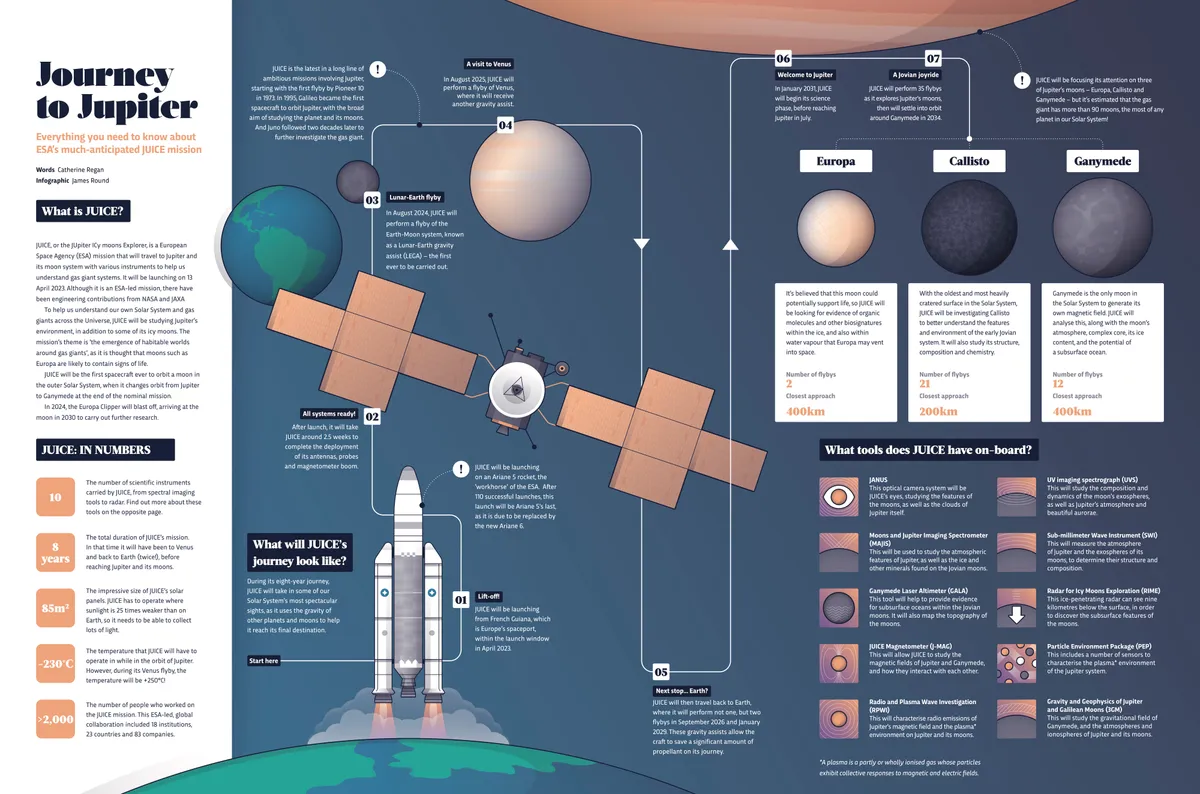The Earth has always been believed to be the gold standard for a habitable world. Lessons learnt from life on Earth have told us that if we want to seek life on other planets in the Solar System, we need to find three basic ingredients in the same place at the same time – liquid water, the chemical building blocks of life, and a source of energy. Previously, we thought that these could only be found within a narrow ring around the Sun called the ‘Goldilocks Zone’, or ‘Habitable Zone’.
But we were wrong.
Images of Jupiter’s moons taken by the Voyager missions in 1979 and the Galileo spacecraft between 1995 and 2003 completely reshaped our view of the Solar System. They exposed evidence for liquid water in the outer reaches of our planetary neighbourhood, far from where we thought it should be able to exist.
Today, we know that the fourth largest moon of Jupiter, Europa, contains more water than all of Earth’s oceans combined.
What is JUICE?
JUICE, or the JUpiter ICy moons Explorer, is a European Space Agency (ESA) mission that will travel to Jupiter and its moon system with various instruments to help us understand gas giant systems. It will be launching on 13 April 2023. Although it is an ESA-led mission, there have been engineering contributions from NASA and JAXA.

To help us understand our own Solar System and gas giants across the Universe, JUICE will be studying Jupiter’s environment, in addition to some of its icy moons. The mission’s theme is ‘the emergence of habitable worlds around gas giants’, as it is thought that moons such as Europa are likely to contain signs of life.
JUICE will be the first spacecraft ever to orbit a moon in the outer Solar System, when it changes orbit from Jupiter to Ganymede at the end of the nominal mission.
In 2024, the Europa Clipper will blast off, arriving at the moon in 2030 to carry out further research.
[highlight-box]JUICE: In numbers:
- 10: The number of scientific instruments carried by JUICE, from spectral imaging tools to radar.
- 8 years: The total duration of JUICE’s mission. In that time it will have been to Venus and back to Earth (twice!), before reaching Jupiter and its moons.
- 85m2: The impressive size of JUICE’s solar panels. JUICE has to operate where sunlight is 25 times weaker than on Earth, so it needs to be able to collect lots of light.
- -230°C: The temperature that JUICE will have to operate in while in the orbit of Jupiter. However, during its Venus flyby, the temperature will be 250°C!
- > 2,000: The number of people who worked on the JUICE mission. This ESA-led, global collaboration included 18 institutions, 23 countries and 83 companies.
Why Jupiter?
It turns out that Jupiter, despite being outside our Solar System’s traditional habitable zone, has created a habitable zone all of its own, driven not by the Sun’s warmth – sunlight at Jupiter is 30 times dimmer than at Earth – but by the effects of its incredibly powerful gravity.
Given these new ‘cooler’ habitable options, in April 2023 the JUICE mission is heading to Jupiter’s moons to help astrobiologists understand how habitable worlds have emerged in the outer Solar System.
JUICE will uncover the biological effects of the interaction between a planet and its moons by exploring three of Jupiter’s icy moons: Ganymede, Callisto and Europa, and their watery subsurface environments.
Ganymede will take a fair share of the focus of JUICE, but the results it might obtain from Europa, in collaboration with NASA’s Europa Clipper, will be incredibly exciting as it will be the first time we are able to study present-day environments suitable for life beyond the Earth.
Why is JUICE looking for water?
Liquid water is at the top of the astrobiological wishlist when exploring other planets, as it dissolves nutrients and transports chemicals within the environment. Water could help to store and circulate the chemicals for life throughout a planetary body, and Europa has water aplenty.
A large part of Europa’s water is frozen, creating a bright, icy crust; a landscape, unlike anything the Earth has to offer. This glacial shell encompasses the entire moon and is thought to be between 16 and 24 kilometres thick, but is floating atop a salty liquid ocean between 64 and 160 kilometres deep that is in direct contact with a rocky seafloor.
[image id="141434" size="full" align="none"] As seen in this artist’s impression, one of the most striking features of Europa is the array of reddish-coloured lines that criss-cross the surface © NASA/JPLThe most striking features of this ice are the criss-crossing double ridges and grooves of reddish-brownish non-ice material (water mixed with magnesium sulphate and sulphuric acid, for example) that scar the surface. Recent studies of similar ridges on the Greenland ice sheet have hinted that these might be created by pockets of liquid water near to the surface of the ice shell being squeezed upwards from the underlying ocean through fractures in the ice.
It is generally agreed that there is an ocean within Europa, but we haven’t directly seen it yet. The best evidence that this ocean exists is indirectly due to the observation that a magnetic field is created within Europa, as Jupiter’s powerful magnetic field sweeps past the moon – a global ocean of salty water is the most likely thing that could create this.
In addition, there is growing evidence for plumes of water vapour erupting from its surface, similar to those most commonly associated with one of Saturn’s moons, Enceladus. The icy surface also appears to be young, or at least parts of it are. It doesn’t have many impact craters on it like other moons, which means geological activity such as warmer ice rising from an ocean below, could be erasing the craters and allowing Europa to maintain its relatively youthful appearance.
Europa may have other processes at work
As with any planetary body, Europa may have a number of processes that are working together and independently to make the energy needed for powering life. Yet given how far the moon is from the Sun, this life won’t be powered by photosynthesis using solar heat, but most likely by chemical reactions occurring across the surface and within the ocean.

Europa’s surface is blasted by radiation from Jupiter which interacts with the icy crust and other materials, altering them into some of the chemical building blocks of life including free oxygen, hydrogen peroxide, carbon dioxide and sulphur dioxide. The oxygen, for example, if it makes its way to the ocean, could be used in chemical reactions that release energy for life to exploit.
Reactions between the salty water and the rocky ocean floor could also create nutrients to support life. The ocean interacts with hot rock emanating from the sea floor, then that water could be pouring out chemical nutrients that can power life, just like the hydrothermal vents in Earth’s oceans.
Internal heat energy from Europa, perhaps enough to help maintain the liquid ocean in the first place, could also be useful and would be created as the icy moon gets squeezed in and out by the tug of Jupiter’s gravity, in a process called tidal flexing.
In addition to liquid water and energy, for Europa to be potentially habitable, it needs to have the essential elements for life – carbon, hydrogen, nitrogen, oxygen, phosphorus and sulphur. We think these were present on the moon as it formed, with more added over billions of years by the impact of comets and asteroids; and will be found within its icy shell, watery ocean and rocky core.
Underground life on Europa
On the face of it, Europa isn’t welcoming to life. Its surface is bathed in extreme radiation and daytime temperatures barely surpass -160°C. None of the currently known terrestrial extremophilic lifeforms could survive these harsh conditions, and as such we think that any life on Europa will be relegated underground where more protected and relatively clement environments can be found.

Studies on the Earth have reinforced this idea. Since the 1970s we have discovered more than 370 lakes hidden beneath several kilometres of glacial ice in Antarctica (many with microbial life within them), bacteria living in sandstones in the cold, dry, inhospitable Antarctic Dry Valleys, and thriving ecosystems around hydrothermal vents deep beneath the world’s oceans.
The Earth has shown us that life lives in colder, darker, stranger places than we ever dreamed. Today, the idea of life floating around in the liquid ocean under Europa’s ice crust or crowding around mineral-and energy-rich hypothesised deep-sea vents, is widely considered the most promising reservoir for life beyond Earth.
What could life on Europa look like?
Honestly, who knows.
Logically, we think it will be mostly or entirely microbial, like the most extreme-loving life we find on the Earth in Europa-like environments. However, it is always fun to speculate.
Europa’s global ocean may have been in existence for billions of years, more than enough time for evolution to get to work. Europa could have a vigorous biosphere hidden inside its watery depths supporting larger forms of life – perhaps it is filled with Europan octopuses?
It is, of course, unlikely, but we cannot be closed off from this possibility. What is exciting about Europa, is that the life we are talking about is not ancient life or the signatures of its past existence left behind in the minerals and ice, but life that could be living today!
How JUICE will hunt for life
In July 2031 when JUICE arrives in the Jovian system, the solar-powered spacecraft will combine the power of all 10 of its science instruments to uncover the hidden subsurface oceans and habitability potential of Europa, Callisto and Ganymede.

JUICE will perform two Europa flybys and work in collaboration with NASA’s Europa Clipper mission (which sets off in 2024 and arrives in 2030), before culminating its tour with an orbital insertion around Ganymede, its final stop.
Since we are not landing on Europa anytime soon and cannot drill into the ice or directly sample the ocean, we will need to make observations of the surface remotely, and sample indirectly. High-resolution mapping of the surface at multiple wavelengths can help us figure out the composition of the ice and the non-ice reddish material, and assess how habitable the moon could be by searching for biosignatures and determining the distribution of biologically essential elements.
We can also use ice-penetrating radar to map the subsurface structure of the moon down to nine kilometres. We might also be able to get a taste of Europa’s ocean, because it is possible that it may be leaking out into space.
In November 2019, NASA announced it had directly detected water vapour for the first time above Europa’s surface, and we are pretty sure that thin plumes of water are being ejected into space. If the plumes do exist, then JUICE could investigate the dust and other substances being erupted, and if that material originates from the ocean, it could contain molecules that are indicative of life.

Although JUICE isn’t designed to find extraterrestrial life, it will help us assess Europa’s habitability. It will allow us to learn more about the ocean-surface boundary, to what extent the conditions are suitable for biology, and will reveal how geologically active Europa’s interior is.
As scientists, we are always having to change and adapt our thinking, especially with regard to habitability and the extent and limits of life. Thanks to Europa and the future data from JUICE, we are exponentially expanding our catalogue of potentially habitable worlds, not just in our Solar System, but in other solar systems across the Galaxy.
If through JUICE (and subsequent missions and observations) we one day find that life arose on Europa, then life in the Universe could literally be everywhere! If we discover that life didn’t arise on Europa despite all the right conditions, then we will truly marvel at just how unique and special the Earth really is.

Read more: